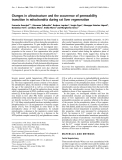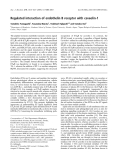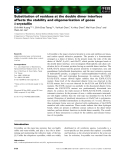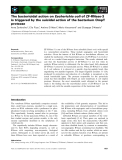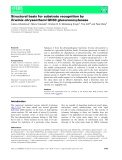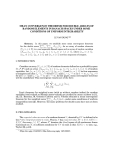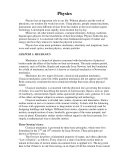
Specialized biological
-
Department of Medical Biochemistry and Biology, University of Bari, Italy; 2Department of Zoology, Laboratory of Histology and Comparative Anatomy, University of Bari, Italy; 3Center for the Study of Mitochondria and Energy Metabolism (CNR) Bari, Italy Mitochondrial bioenergetic impairment has been found in the organelles isolated from rat liver during the prereplicative phase of liver regeneration.
 9p
9p  system191
system191
 01-06-2013
01-06-2013
 37
37
 4
4
 Download
Download
-
The peptide hormone endothelin transmits various signals throughGprotein-coupled receptors, the endothelin type A (ETAR) and B (ETBR) receptors. Caveolae are specialized lipid rafts containing polymerized caveolins. We examined the interaction of ETBR with caveolin-1, expressed in Sf9, COS-1, and HEK293 cells, and its effects on the subcellular distribution and the signal transduction of ETBR.
 12p
12p  fptmusic
fptmusic
 16-04-2013
16-04-2013
 28
28
 2
2
 Download
Download
-
One of the hallmarks of cAMP is its ability to inhibit proliferation in many cell types, but stimulate proliferation in others. Clearly cAMP has cell type specific effects and the outcome on proliferation is largely attributed to crosstalk from cAMP to the RAS⁄RAF⁄mitogen-activated protein kinase (MAPK) and extracellular signal-regulated kinase (ERK) kinase (MEK)/ ERK pathway. We review the crosstalk between these two ancient and con-served pathways, describing the molecular mechanisms underlying the interactions between these pathways and discussing their possible biological importance....
 14p
14p  fptmusic
fptmusic
 11-04-2013
11-04-2013
 41
41
 3
3
 Download
Download
-
d-Crystallin is the major structural protein in avian and reptilian eye lenses, and confers special refractive properties. The protein is a homotetramer arranged as a dimer of dimers. In the present study, the roles of the side chains of Glu267, Lys315, and Glu327, which provide hydrogen bonds at the double dimer interface, were investigated. Hydrophobic side chain sub-stitution led to all mutant proteins having an unstable dimer interface.
 11p
11p  vinaphone15
vinaphone15
 25-02-2013
25-02-2013
 36
36
 2
2
 Download
Download
-
ZF-RNase-3 is one of the RNases from zebrafish (Danio rerio) with special (i.e. noncatalytic) properties. These include angiogenic and bactericidal activities. Given the interest of fish RNases as host-defense effectors, we studied the mechanism of the bactericidal action of ZF-RNase-3 onEscheri-chia coli as a model Gram-negative bacterium.
 8p
8p  mobifone23
mobifone23
 21-01-2013
21-01-2013
 42
42
 4
4
 Download
Download
-
Xylanase A from the phytopathogenic bacteriumErwinia chrysanthemiis classified as a glycoside hydrolase family 30 enzyme (previously in family 5) and is specialized for degradation of glucuronoxylan. The recombinant enzyme was crystallized with the aldotetraouronic acidb-D-xylopyranosyl-(1fi4)-[4-O-methyl-a-D-glucuronosyl-(1 fi2)]-b-D-xylopyranosyl-(1 fi4)-D-xylose as a ligand.
 12p
12p  cosis54
cosis54
 05-01-2013
05-01-2013
 54
54
 5
5
 Download
Download
-
Specifically, the science of physics to the laws of natural movement, from a macroscopic (particles that make up matter) to larger scales (planets, galaxies and the universe). In English, from physics (physics) is derived from Greek φύσις (phusis) means natural and φυσικός (phusikos) is of the nature. The main object of study now include physical matter, energy, space and time.
 7p
7p  phalinh14
phalinh14
 07-08-2011
07-08-2011
 60
60
 5
5
 Download
Download
-
Collection of research reports best universities honored author. Two. Le Van Dung, a number average convergence theorem for two index array of random elements in Banach spaces with integrable conditions are ... Science (in Latin Scientia, meaning "knowledge "or" understanding ") is the efforts to implement the invention, and increased knowledge of the human understanding of how the operation of the physical world around them.
 10p
10p  phalinh14
phalinh14
 07-08-2011
07-08-2011
 67
67
 4
4
 Download
Download
-
Physics has an important role in our life. Without physics and the work of physicists, our modern life would not exist. Using physics, people created machines, instruments and some different divices from the crudest to the most modern aspect. Techology is developed more rapidly, more modern day by day. Moreover, all other natural sciences- example chemistry, biology, medicinedepend upon physics for the foundations of their knowledge.
 17p
17p  tieulaubau
tieulaubau
 21-06-2011
21-06-2011
 88
88
 5
5
 Download
Download
CHỦ ĐỀ BẠN MUỐN TÌM








